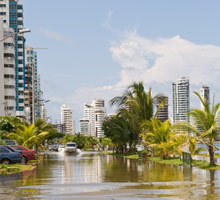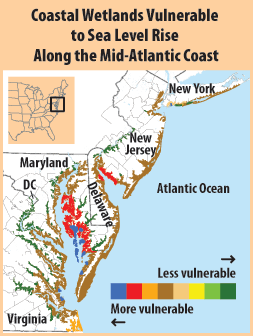Coastal Areas
Global climate change threatens coastlines and the buildings and cities located along them. Hundreds of millions of people around the world live in low–lying areas near the coast that could be flooded as the sea level rises. Rising sea level will also erode beaches and damage many coastal wetlands. Rising sea level and stronger storms caused by warmer oceans could completely wipe out certain beaches and islands.
What's at stake?
Coastal Cities
 Climate change poses risks for cities near the ocean. Places like Miami; New York City; New Orleans; and Venice, Italy, could flood more often or more severely if sea level continues to rise. If that happens, many people will lose their homes and businesses.
Climate change poses risks for cities near the ocean. Places like Miami; New York City; New Orleans; and Venice, Italy, could flood more often or more severely if sea level continues to rise. If that happens, many people will lose their homes and businesses.
- What can people do about it?
Coastal cities can prepare for climate change by protecting or restoring natural shoreline buffers like sand dunes and wetlands, improving storm drainage systems, and building protective barriers where necessary.

This map shows how rising sea level threatens wetlands along the U.S. Mid-Atlantic Coast. The more vulnerable a wetland is, the more likely it will become submerged (and disappear) as sea level rises in the future. Source: Adapted from U.S. Climate Change Science Program (2009).
What's at stake?
Coastal Wetlands
Climate change will damage coastal wetlands all over the world. Wetlands protect the shore from flooding, and they also provide important habitats for many types of plants and animals. For example, the Everglades are wetlands close to sea level in southern Florida that are home to diverse ecosystems. As sea level rises, salt water could flood parts of the Everglades, leaving animals such as birds, alligators, turtles, and panthers with less habitat.
- What can people do about it?
People can protect wetlands as much as possible by not disturbing the land, the flow of water, or plants in these areas.
Learn more
- Take an expedition to the Maldives to learn more about sea level rise and how it will affect coastal areas.
- Find out more about how people can prepare for rising sea level and stronger coastal storms.